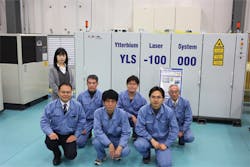ILS editorial advisor Dr. Kunihiko Washio, on a lab tour at the NADEX Laser R & D Center (Tsuruga, Japan), witnessed the following experiment with a 100kW fiber laser welding SUS 304 stainless steel at 100kW (1mm-diameter spot size):
In air with N2 shield gas
• Penetration depth of 40mm at welding speed of 2 m/min.
• Penetration depth of 38mm at welding speed of 3 m/min.
In vacuum (1kPa)
• Penetration depth of 100mm at 50kW
• Penetration depth of 125mm at 70kW
I contacted Keiichi Suzuki, Corporate Officer at the Center, who contributed the news item that follows. —DAB
NADEX Co., Ltd. (Aichi Prefecture, Japan) is an enterprise that has been doing business with the automotive industry since the 1950s, focusing on the manufacture and sales of resistance spot welding systems. This company has been developing new joining technologies as an industry/academia government project in cooperation with the Joining and Welding Research Institute of Osaka University and Fukui Prefectural Government. They established NADEX Laser R&D Center in Fukui Prefecture, where the world's largest IPG Photonics 100kW fiber laser is installed.
IPG Photonics' YLS-100000 oscillator is a multimode laser oscillator that consists of 90 modules having a 0.3mm-diameter feeding fiber connected to a 0.5mm-diameter process fiber, with output energy densities of 51MW/cm2 at the fiber end.
In developing the output optics, it is important to enhance the focusing stability and the stability of the convection in a welding keyhole melting pool generated by the laser for which the optimum threshold needs to be determined. Gas shielding of the protection window glasses also affects the stability of the optic materials and application technology is indispensable. Because low heat input is a feature in 100kW laser processing, the weld bead is kept in a liquid form after melting by trialing a gas-style nozzle suitable for the shape and material of the work piece.
NADEX has been proposing various laser processing techniques, primarily to the automotive industry, through processing trials with this laser in collaboration with customers. NADEX is accumulating experiments at a higher speed and with a heavier metal plate to expand the field of application in cooperation with partners in heavy industry.
Multi-layer arc welding, a time-consuming process, has been dominant in the field of heavy plate welding for shipbuilding and pressure vessel fabrication. NADEX intends to expand its business in this field by using technical innovation applying laser welding, as well as building closer relations with existing customers by feeding back solutions to the technical problems encountered in the course of development.
Laser systems widely used today are rated around the 4kW output range. In most cases, they are used for fusion joining with high weld quality. In laser processing with the 100kW laser, problems encountered in laser processing appear clearer, which allows us to investigate the root cause and mechanism of the problems in more detail. By making the best use of this advantage, NADEX is trying to become a leading company in the super-high-power laser process.
The company has been using the 100kW laser oscillator for one and a half years, and they found that this laser has no big difference with a 4kW laser oscillator in terms of ease of use. The only differences seem to be higher expenditure for test pieces, larger weld spatter deposition, and output optics that are slightly bigger.
Those interested in joining NADEX in innovating new technologies with the 100kW laser system can contact keiichi.suzuki@nadex-p-jp.
